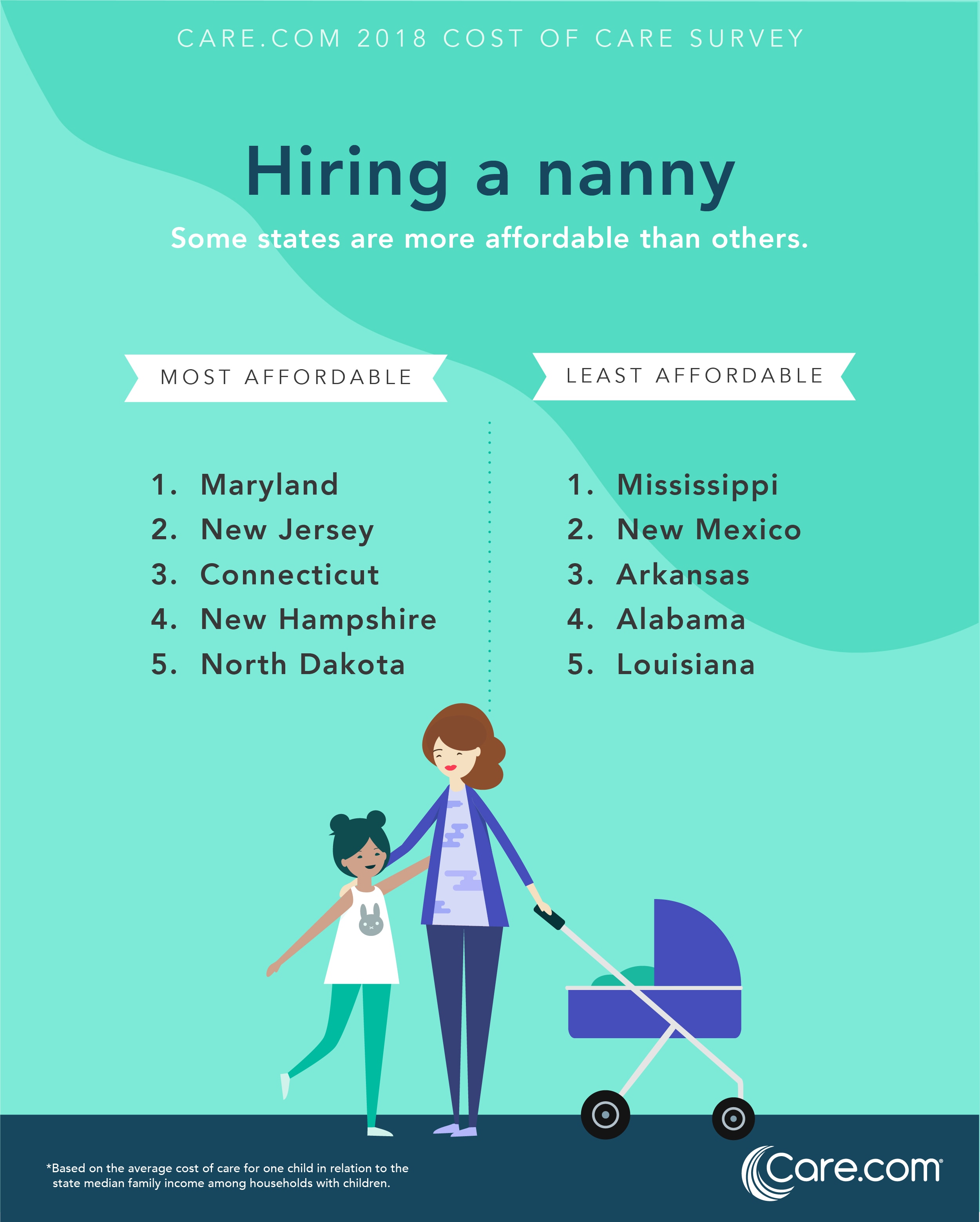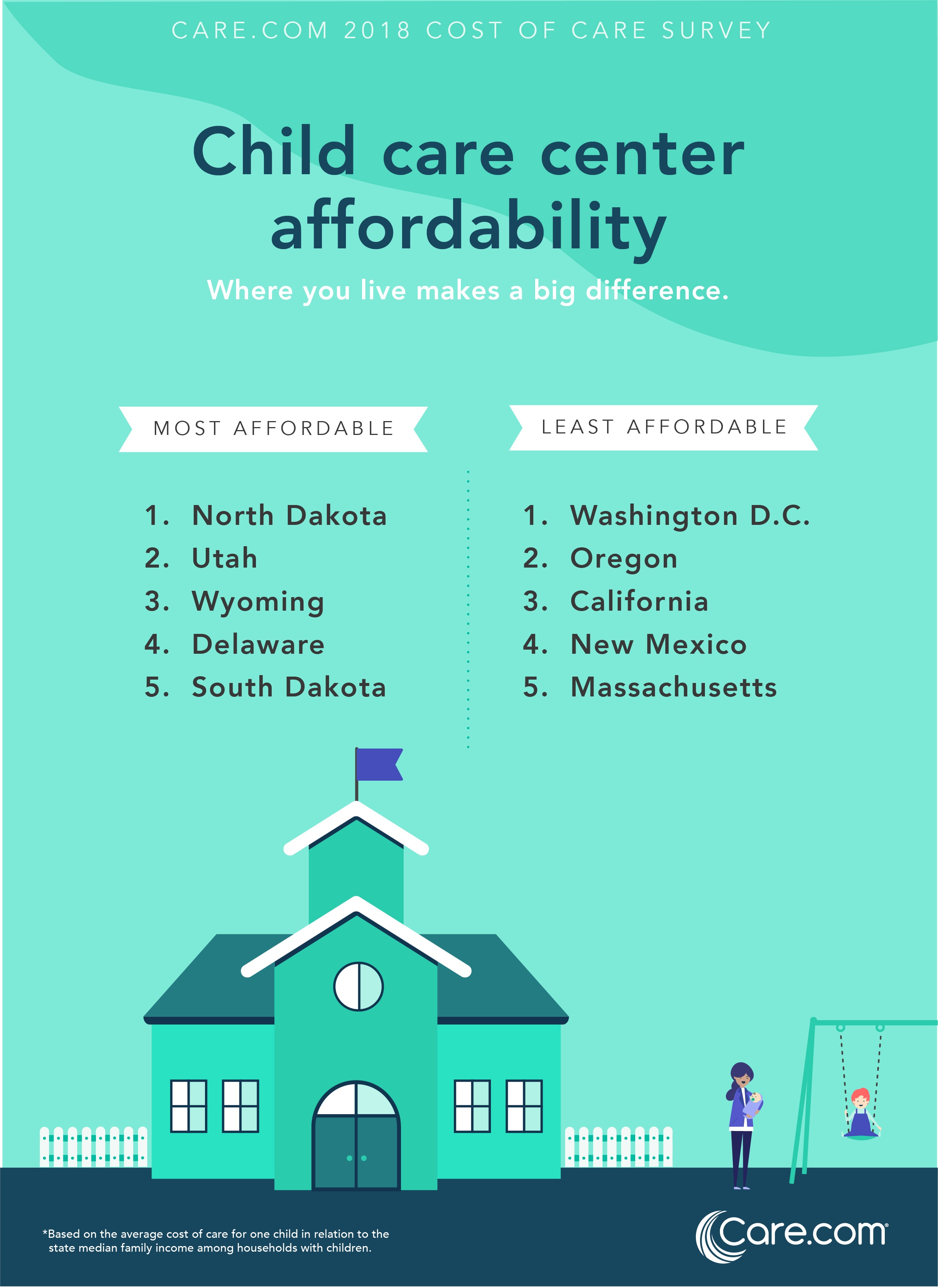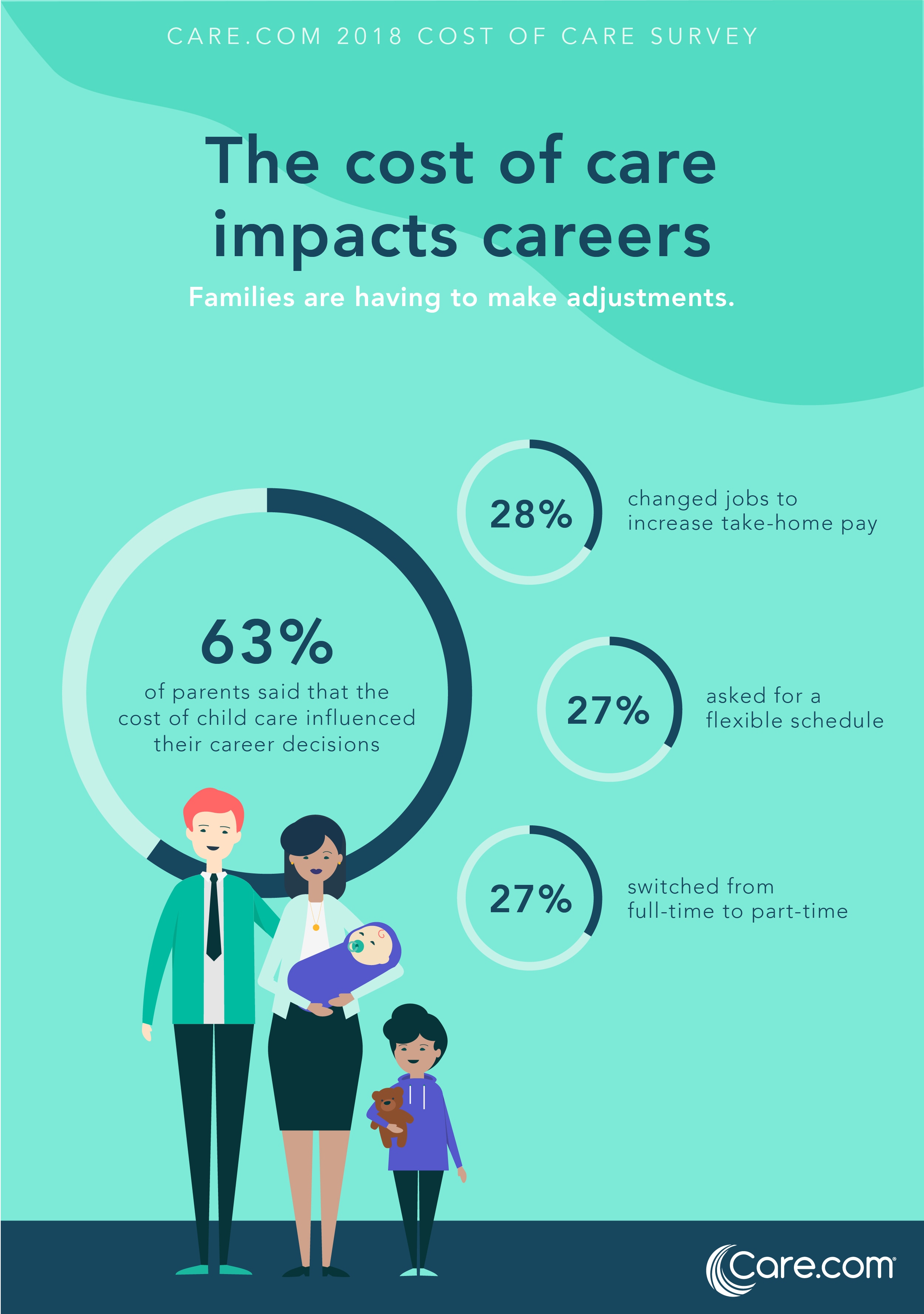Read the Care.com 2023 Cost of Care Report: This is what child care costs in 2023
Child care costs rose for the fifth year in a row, according to the fifth annual Care.com Cost of Care Survey, which showed that the average weekly cost for an infant child is $211 for a day-care center, $195 for a family care center, and $580 for a nanny. The survey compiles in-depth insights from more than 1,000 parents nationwide about their child care spending habits, including the rising costs of after-school sitters, day care, and nannies.
The most stunning finding: One in three families (33%) now spend 20% or more of their annual household income on child care. Seven in 10 families report paying rates higher than the U.S. Department of Health and Human Services’ definition of affordable care, while nearly one in five families spends a quarter or more of their household income on child care. And 60% say child care costs have increased in the past year, leading to many families adopting budgeting tactics such as reducing date nights and cutting back on cable. In fact, the survey found that the average weekly rate for a nanny has risen over $100 since 2013. In a year that saw the U.S. fertility rate hit a record low, the survey shows that one in three families (33%) say the cost of child care influenced their family planning, in that they either waited longer to have children or had fewer children than they would have liked because of child care costs.
How much does child care cost?
Care.com found that child care is less affordable for families than it was a year ago: One in three families (33%) spend 20% or more of their household income on child care; 19% of families spend 25% or more; and a whopping 71% spend at least 10% of annual income. The U.S. Department of Health and Human Services defines affordable child care as costing up to 7% of household income.
Child care costs depend on a number of different factors, including type of care provided and the location. To illustrate this point, let’s look at the cost of two of the most popular child care options in the United States: day cares (also referred as “child care centers“) and nannies.
According to Care.com member data, the annual cost of center-based day care for infants ranged from $6,615 in Arizona to $19,805 in Washington, DC. The annual cost for a nanny caring for one child was just $27,566 in Utah, but $34,592 in Massachusetts.
INTERACTIVE: Use our Cost of Child Care Calculator to find the cost of different child care options near you.
Below are the national averages of weekly child care costs for each type of care, mapped over the past five years.
*National average weekly rates:
|
Data YEAR |
2017 |
2016 |
2015 |
2014** |
2013** |
|
$580 |
$565 |
$557 |
$477 |
$472 | |
|
$242 |
$232 |
$214 |
$197 |
$181 | |
|
$211 |
$211 |
$196 |
$188 |
$186 | |
|
$195 |
$200 |
$181 |
$140 |
$127 | |
|
$390 |
$367 |
$360 |
$360 |
$360 |
*all rates are for one infant child, except for after-school sitter, which is not age limited.
**all 2013 and 2014 figures were based off of Child Care Aware’s national data.

A joint Care.com and New America study found that the cost of child care — along with the quality and availability of that care — can vary dramatically depending on where you live. That’s because the overall costs associated with living in a particular area (e.g., the price of food, housing, public transportation) directly influence the salaries and pay rates for different jobs. It follows, then, that the cost of living in your state not only impacts how much money you need to make in order to support your family, but also determines how much money a child care provider can charge you for their services.
[RELATED: “Cities vs. Suburbs: Where Can American Parents Save the Most Money?“]
To illustrate this point, we looked at the data on a state-by-state basis to identify the most and least affordable states for both types of child care options:
| TOP 5 MOST AFFORDABLE STATES FOR A NANNY** |
| 1. Maryland |
| 2. New Jersey |
| 3. Connecticut |
| 4. New Hampshire |
| 5. North Dakota |
| TOP 5 LEAST AFFORDABLE STATES FOR A NANNY** |
| 1. Mississippi |
| 2. New Mexico |
| 3. Arkansas |
| 4. Alabama |
| 5. Louisiana |
| TOP 5 MOST AFFORDABLE STATES FOR A DAY CARE** |
| 1. North Dakota |
| 2. Utah |
| 3. Wyoming |
| 4. Delaware |
| 5. South Dakota |
| TOP 5 LEAST AFFORDABLE STATES FOR A DAY CARE** |
| 1. District of Columbia |
| 2. Oregon |
| 3. California |
| 4. New Mexico |
| 5. Massachusetts |
**Based on the average cost of care in relation to the state median family income among households with children.

What is the financial and familial impact of child care costs?
American families will go to great lengths to pay for child care. In fact, 26% would put themselves in debt or further debt to pay for child care, and parents report they’ve saved less money (54%) and made major budget cuts (41%) to pay for the rising cost of care. These increased costs are leading to more stress. More than one in three (35%) parents say child care costs have caused tension in their relationship with their partner. And one in three families (33%) say the cost of child care influenced their family planning, in that they either waited longer to have children or had fewer children than they would have liked because of child care costs.
Are families aware of child care costs?
Child care remains the cost that surprises parents the most when they start having children, followed by formula and diapers. With three in four families (75%) reporting that child care costs were more than they expected, the impact of these increasing costs is causing new parents to feel a bit of sticker shock. The good news is 68% of families are now budgeting for child care, up from 58% in 2014. And they’re doing the research on care prices: 72% look online for more information on costs, 68% turn to friends and family, and 51% ask about rates during the interview process for hiring nannies, sitters or day care centers.
How does child care influence career decisions?

The high cost of care doesn’t merely impact the home: It also has significant influence on parents’ career decisions. More than three-fourths (77%) of parents say they didn’t anticipate the cost of child care would impact their career decisions — and yet 63% report that it did. The most common adjustments are changing jobs to increase take-home pay (28%), asking for a more flexible work schedule (27%), switching from a full-time to part-time schedule (27%), and becoming a stay-at-home parent (22%). In retrospect, nearly one in four parents (24%) wouldn’t have made the same career decisions given the cost of child care.
What can parents do to reduce the cost of care?
There are several ways families can mitigate the high costs of child care. Once families know how much they can afford, they can pinpoint the most feasible child care option by researching the current rates in their area with free, interactive tools, like local nanny rates and nanny tax calculators. Families can also take advantage of tax breaks that can save thousands of dollars.
“Many families miss out on saving a considerable amount of money through tax breaks available to them,” says Kerri Swope, Vice President of Care.com HomePay, a leading provider of comprehensive household payroll, tax and HR services. “Contributing to a Dependent Care Flexible Spending Account (FSA) can help families save as much as $2,300 per year — but the Care.com 2018 Cost of Care Survey found that only 55% of families actually contribute to one. In addition to the FSA, families can take advantage of the Child and Dependent Care Tax Credit, which can save up to $600 for families with one child and $1,200 for families with two or more children.”
Can employers help working parents and their companies?
Another way working families are affording care is that they’re looking to their employers. Over half of American families (53%) agree that workplaces should provide benefits — such as flexible work schedules and paid parental leave — to support working families. However, an overwhelming 81% of working parents say their employer doesn’t offer any kind of child care benefits, with 83% wishing they did. And businesses should note that 72% of parents say their work day has been impacted by child care falling through, with 67% using a sick day, 56% being late to work, 39% using a vacation day, and 26% falling behind on work as a result.
“The Care.com 2018 Cost of Care Survey clearly shows more and more working parents are realizing that child care costs have a substantial impact on their careers,” said Alyssa Johnson, Vice President of Global Account Management for Care For Business, Care.com’s enterprise solution helping companies support working families. “The reality is that while child care needs are unpredictable, the impact on a business is not. When care breaks down, people miss work. They can’t focus and they leave jobs. The employers we’ve worked with realize that in order to maintain an engaged, productive workforce they need to provide care support to their working parents, which in turn significantly influences a company’s overall performance and bottom-line results.”
How do parents feel about the country’s cost of care?
Despite the increase in families budgeting for child care and finding ways to reduce costs, families are still struggling. Over half of families (55%, up from 53% in 2017) agree that American culture does not do enough to support working parents when it comes to the cost of care, and nearly half of families (46%) wish the United States subsidized child care costs as some other countries do.
Care.com 2018 Cost of Care methodology
The Cost of Care Survey is an annual survey to measure the relative cost of care in the U.S. and how care impacts families’ budgets and employment. The Care.com 2018 Cost of Care Survey captured responses from more than 1,300 parents in the United States during the month of May 2018. Respondents were recruited from Care.com.
Weekly rates for a nanny and after-school sitter are based on Care.com 2017 member data, child care center and family care center rates are based on rate information from centers listed on Care.com, and au pair rates, which are based on data from Cultural Care Au Pair, Au Pair in America, and Au Pair Care. Affordability rankings are calculated based on the average cost of care in relation to the U.S. Census Bureau’s 2016 American Community Survey that includes the state median family income of households with children.






